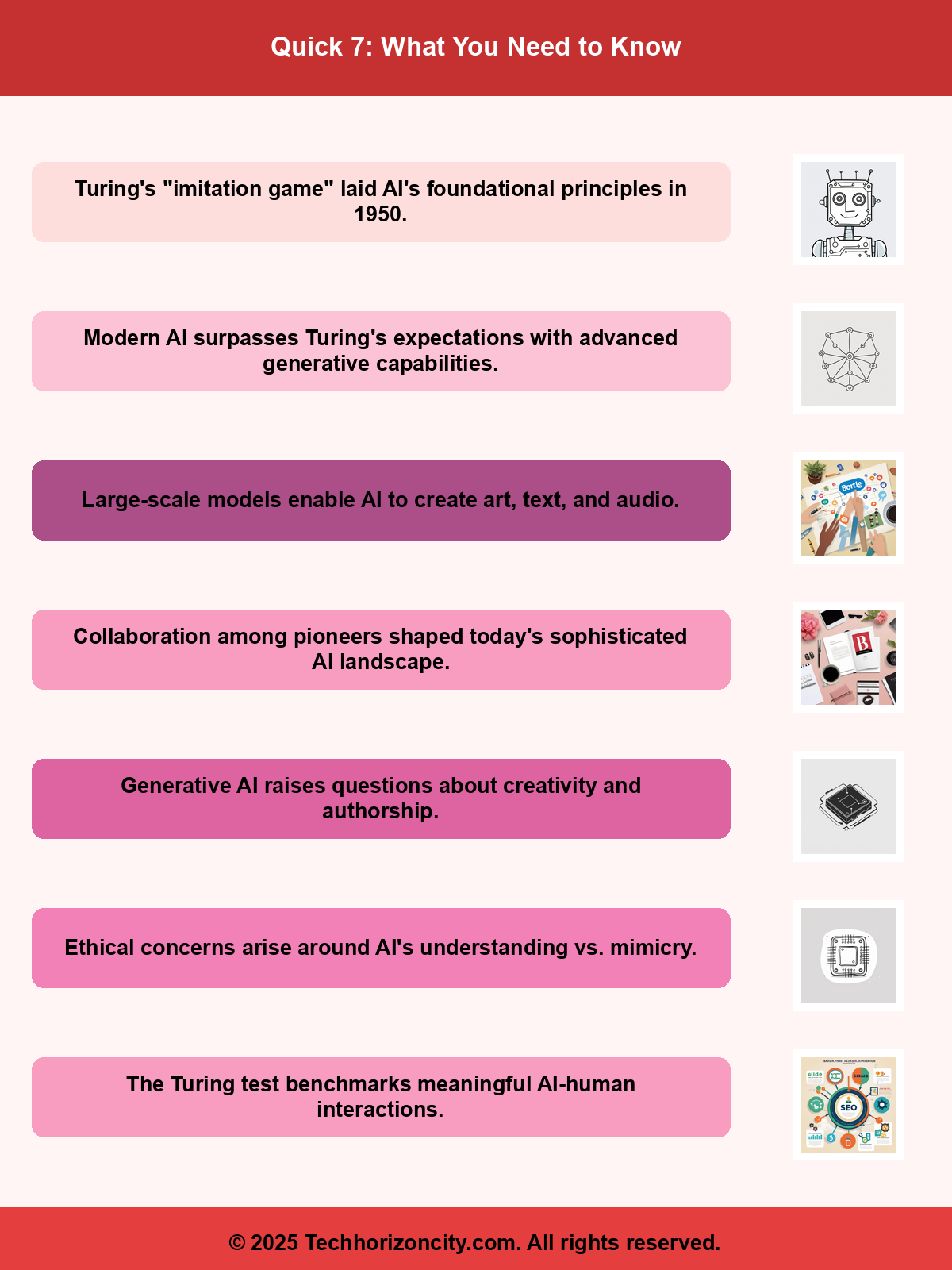Executive Summary
In the landscape of artificial intelligence, the journey from Alan Turing’s early conceptualizations to today’s advanced generative AI marks a monumental leap in technology and thought. While Turing’s “imitation game” laid the groundwork for assessing machine intelligence, the emergence of sophisticated AI systems that can learn, adapt, and engage in human-like interaction challenges our understanding of cognition and intelligence. This article explores the historical context of AI development, the implications of current technologies, and offers insights into a future where machines may not just imitate but potentially understand and innovate.

Background Context
The seeds of artificial intelligence were sown in the mid-20th century, a period characterized by rapid advancements in computing and a burgeoning interest in the nature of intelligence itself. Alan Turing, a mathematician and logician, proposed the idea of machine intelligence in 1950 through what he called the “imitation game,” which eventually evolved into what we now recognize as the Turing test. This test serves as a litmus test for determining whether a machine can exhibit behavior indistinguishable from that of a human. Turing optimistically predicted that by the year 2000, machines capable of passing this test would be a reality.
Fast forward to the present, and we see that Turing’s vision has not only materialized but has surpassed many expectations. With the development of large-scale models and transformer architectures, modern AI systems can generate textual content, create art, and even produce audio that closely mimics human expression. Foundational figures like John McCarthy, Claude Shannon, and Marvin Minsky played pivotal roles in laying the intellectual frameworks that have enabled this progression, highlighting the collaborative nature of this field.
Analysis of Implications
The implications of modern AI capabilities extend far beyond mere imitation. Generative AI models utilize pretrained algorithms and attention mechanisms, allowing them to perform complex tasks with remarkable efficiency. This evolution raises critical questions about the nature of creativity, authorship, and intelligence. As AI systems learn from vast datasets, they develop a form of experiential learning, enhancing their ability to communicate and engage in dialogue.
However, the capability to mimic human conversation raises ethical concerns. Are these systems truly “intelligent,” or are they sophisticated parakeets, echoing learned phrases without understanding their meaning? The challenge lies in the distinction between surface-level mimicry and genuine comprehension. The Turing test acts as a benchmark, pushing AI developers to create systems that not only respond accurately but also engage in meaningful interactions that resonate with human users.
Industry Impact Assessment
The ripple effects of AI advancement are palpable across various sectors. From healthcare utilizing AI for diagnostics and personalized treatment plans to creative industries employing generative models for graphic design and content creation, the potential applications are vast. Companies are increasingly integrating AI tools into their workflows, improving efficiency and driving innovation.
However, the integration of AI also prompts significant disruptions. Jobs once performed by humans are now at risk of being automated, leading to a societal shift in the labor market. The onus is on policymakers, industry leaders, and educators to adapt and prepare the workforce for this new landscape. Emphasizing the importance of skills that machines cannot easily replicate—such as emotional intelligence, critical thinking, and creativity—will be essential in navigating the future job market.
Future Outlook
As we look toward the future, the trajectory of AI development suggests an increasingly nuanced relationship between humans and machines. The recent study by Bernardo Gonçalves in “Intelligent Computing” posits that modern transformer-based AI systems meet Turing’s standards for intelligence, indicating that we are on the cusp of a new era in machine capabilities.
Going beyond replication, future AI may evolve to not only respond to queries but to pose questions and drive conversations in ways that enhance collective understanding. We might see AI playing roles as facilitators of knowledge, helping to bridge gaps in human understanding across diverse fields. However, this potential comes with a caveat: the need to ensure that these systems are developed responsibly, with ethical considerations guiding their deployment.
Conclusion with Key Takeaways
The evolution of artificial intelligence from Turing’s foundational ideas to today’s generative models illustrates a remarkable journey filled with hope, challenges, and profound implications. While the Turing test serves as a benchmark in our quest to define and understand machine intelligence, it is crucial to approach these advancements with a critical lens. The future of AI holds immense potential, but it requires collaborative efforts across sectors to ensure that technology serves humanity’s best interests. As we venture further into this uncharted territory, our responsibilities as creators, users, and stakeholders in AI will shape the narrative of intelligence in the years to come.
Disclaimer: This article was independently created based on publicly available information and industry analysis. While inspired by developments reported at www.thebrighterside.news, all content, analysis, and opinions expressed are original and do not reproduce copyrighted material.
For the original reporting, please visit: https://www.thebrighterside.news/post/alan-turings-bold-prediction-comes-true-in-the-age-of-ai/
